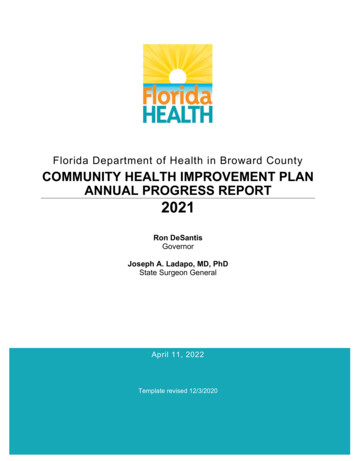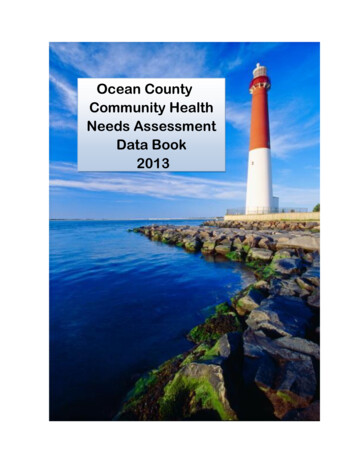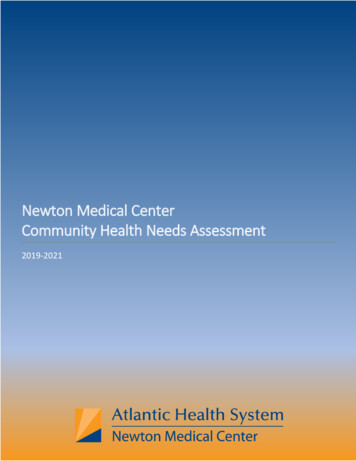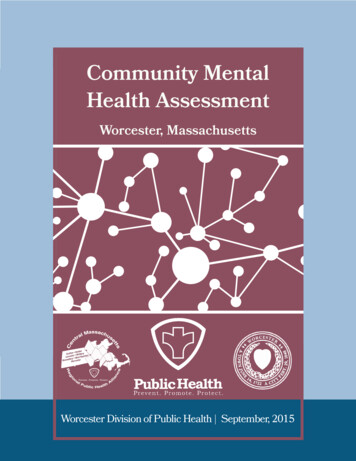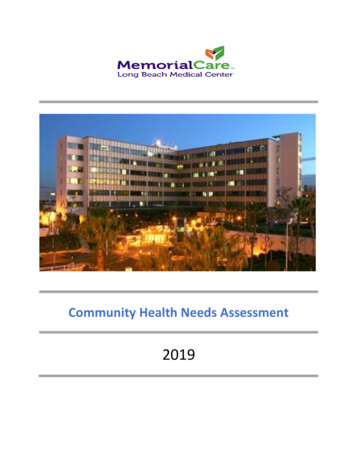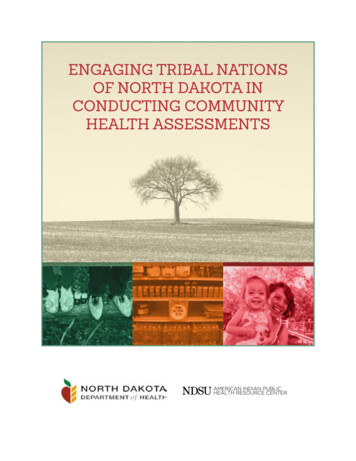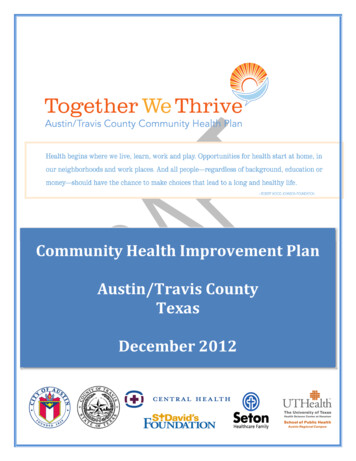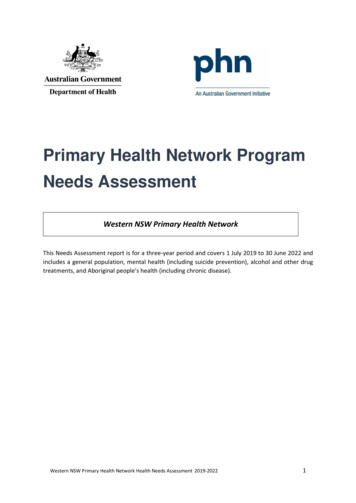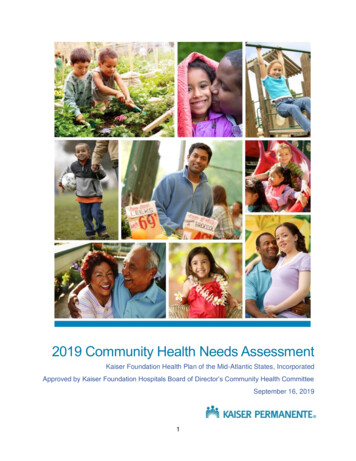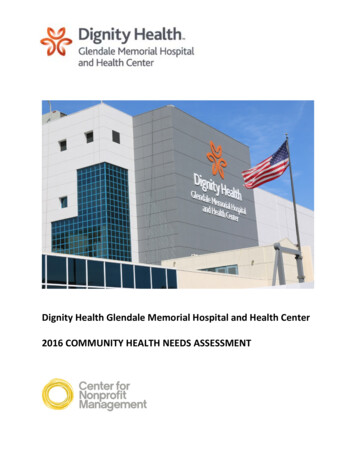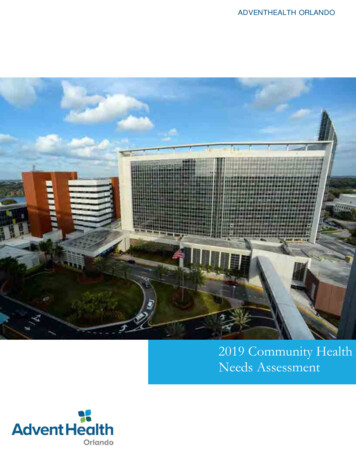
Transcription
ADVENTHEALTH ORLANDO2019 Community HealthNeeds Assessment
Table of ContentsChapter 1: IntroductionChapter 2: Executive SummaryChapter 3: AdventHealth Orlandoand the Surrounding CommunityChapter 4: MethodologyChapter 5: Top Community Health NeedsChapter 6: Community Profile of Orange CountyChapter 7: Health Needs of the CommunityChapter 8: Health DisparitiesChapter 9: Hot Spotting SummaryChapter 10: Compliance and PrioritiesAppendix A: Primary Data Collection Tools
This report was prepared by AdventHealth Central Florida Division-South Region’s Community Health team.Special thanks to Strategy Solutions, Inc. for their support and contribution in the process.Questions or comments can be directed to FH.Community.Health@AdventHealth.com.
CHAPTER ONEIntroductionKraft Azalea Park WinterPark, FLOrange County
MESSAGEFROMTHELEADERAdventHealth Central Florida Division80,000Minds OnePurposeNo matter what brings you in, no matter which of our providers, facilities ormedical services you need, we’re all connected by more than just our name.We’re connected by our commitment to your whole-person health.At AdventHealth, we have a sacred mission of Extending the HealingMinistry of Christ. That mission extends far beyond our walls and intothe communities we serve. Our commitment is to address the needs ofour community with a wholistic focus. That wellness isn’t just about thephysical, but also includes mental, spiritual, environmental and socialhealth. We want to help our neighbors get well and stay well.As a not-for-profit health care system, we are proud to support andpartner with other organizations that share our vision of a healthier,more whole Central Florida.We have once again worked with Orlando Health, Aspire HealthPartners and the Departments of Health to produce this CommunityHealth Needs Assessment (CHNA). Our partnership has expanded toinclude the local Federally Qualified Health Centers (FQHCs), whichwill further help us identify where we can have the most impact on thehealth of Central Florida.We’re committed to helping address Central Florida’s greatest healthchallenges. From expanding mental health services to fighting foodinsecurity to reducing chronic diseases, we’re working to bring changeand empower our neighbors to live their healthiest lives.Daryl TolPresident & CEOAdventHealth Central Florida Division
Advent H e a l t h – Central Florida Division Executive Office Building
Introduction to the Community Health Needs AssessmentThank you for being part of our community.AdventHealth Orlando is proud to present our 2019 Community HealthNeeds Assessment (CHNA). AdventHealth Orlando is part of theAdventHealth Central Florida Division South Region. This reportsummarizes a comprehensive review and analysis of public health,socioeconomic and other demographic data from our immediateservice area within Orange County, Florida. It also includes inputgathered directly from local residents and stakeholders. All data wasreviewed and analyzed to determine the top health issues facing ourimmediate and surrounding communities.To conduct this CHNA, AdventHealth Orlando participated in the CentralFlorida Community Collaborative (the Collaborative), which included:AdventHealth Central Florida Division, Aspire Health Partners, OrlandoHealth, the Departments of Health in Lake, Orange, Osceola and Seminolecounties, Community Health Centers, Inc., Orange Blossom Family Health,Osceola Community Health Services and True Health.This CHNA will assist our hospital, community organizations and socialservice agencies to identify community health needs and developstrategic interventions to improve the health of the communities weserve.We offer special thanks to the many community-based organizations andmore than 1500 citizens and stakeholders that participated in thisassessment. We appreciate their time and valuable input throughout theCHNA process.Thank You!
CHAPTERTWOExecutive SummaryWekiwa Springs State ParkApopka, FLOrange County
Formerly known as Florida Hospital Orlando, Adventist Health System/Sunbelt, Inc. dba AdventHealthOrlando will be referred to in this document as AdventHealth Orlando or “the Hospital.” AdventHealthOrlando conducted a Community Health Needs Assessment in 2019. The goals of the assessment were to: Engage with the community, targeting underrepresented populations, to understand their uniqueneedsConnect with public health representatives and community stakeholders serving low-income,minority and other underrepresented populationsAssess and understand the community’s health issues and needsUnderstand the health behaviors, risk factors and social determinants that impact healthIdentify community resources and collaborate with community partnersPublish the Community Health Needs AssessmentUse assessment findings to develop and implement a 2020-2022 Community Health Plan based onAdventHealth Orlando’s prioritized issueData SourcesTo support this assessment, numerous qualitative and quantitative data sources were used to validatefindings using the data triangulation method. The data triangulation method looks at primary data(collected through community input) and two types of relevant local secondary data (either hospitalutilization records/patient data or county, region-specific, or state data) looking for common themes andtrends across all three sources. The data sources used in this method are outlined in Figure 2.1.FIGURE 2.1: DATA TRIANGULATIONSECONDARYDATACOMMUNITYINPUTPATIENT DATAFLHealthCHARTSCommunity Survey: 1,240US Census BureauStakeholder Interviews: 21AdventHealthOrlandoCenters for DiseaseControl and PreventionFocus Groups: Orange 9BRFSS DataHealthy People 2020Other Secondary SourcesKey Informant Survey: 111Intercept Survey: 86
To support the CHNA in Orange County, the Collaborative collected a total of 1,240 community surveys, 111key informant surveys, conducted 21 stakeholder interviews, 9 focus groups with 140 participants and 86intercept surveys.To assist the Collaborative in facilitating this CHNA, Strategy Solutions, Inc. (SSI) was contracted to providesupport for the data collection and identification of priorities. SSI is a planning and research firm with themission to create healthy communities. National best practices were used for the framework of the CHNAincluding: the Association for Community Health Improvement (ACHI, a division of the American HospitalAssociation), the Mobilizing for Action Through Planning and Partnership (MAPP) developed by the NationalAssociation for City and County Health Officials (NACCHO), Healthy People 2020 (HP2020) and the RobertWood Johnson Foundation’s County Health Rankings and Roadmaps. Data were compiled from the mostup-to-date resources. This was augmented with primary research conducted with community residents,providers and stakeholders. Hospital utilization data for the uninsured patient population was also utilizedin this CHNA.Zip code level demographic and socio-economic data for the service area was collected from the U.S. CensusBureau (obtained through Environics Analytics and IBM Market Expert), the American Community Survey andthe Bureau of Labor Statistics.Key FindingsAfter reviewing the primary and secondary data in this CHNA, the following key findings were identified forOrange County and its residents. The goal of the key findings is to deliver a comprehensive overview of thedata, which highlights the strengths and areas of improvement for the community. The key findings arebroken down by themes seen in primary data collection, as well as by strengths and weaknesses identifiedthrough secondary data.COMMUNITY THEMES AS IDENTIFIED BY PRIMARY DATAThe themes were compiled using data from the community surveys, stakeholder interviews, focus groups,key informant surveys and intercept surveys conducted for this CHNA as areas of need or community issues: Need for and access to mental health servicesAccess to affordable health careo Health care costso Inappropriate use of emergency departmento Lack of trust in seeking of medical care due to undocumented statuso Coordination of services for seniorso Access to dental careo Health education/health literacyChronic conditionso Diabeteso Obesityo Asthma/COPDo Heart diseaseo Cancero High cholesterolFood insecurity including access to quality/nutritious foodsPrevalence of substance useo Opioid useo Smoking prevalenceLiving in povertyo Prevalence of stresso Lack of family supporto Need for affordable housingo Residents receiving low wageso Lack of employment opportunitieso Homelessness/affordable housingTransportation
COMMUNITY STRENGTHSThe community strengths assessment includes indicators that improved by 10 percent or more of value since the2016 CHNA or from 2013 to 2015 if the data was not included in the last CHNA: Economic conditionso Persons living below poverty level decreasedo Unemployment rate decreasedSchool and student demographicso High school gang activity decreasedCommunicable diseaseso Influenza vaccinations for adults aged 65 and older increasedPreventative serviceso Women aged 40 and older who received a mammogram in past year increasedo Adults aged 50 and older who received a stool test in past year increasedChronic conditionso Diabetes hospitalizations for children ages 5-11 decreasedo Preventable hospitalizations for adults under age 65 from congestive heart failure decreasedo Colorectal cancer incidence decreasedo Lung cancer incidence decreasedo Adults who currently have asthma decreasedo Asthma hospitalizations for ages 1-1 and ages 5-11 decreasedInjuryo Unintentional drownings decreasedQuality of life/mental healtho Adults who have ever been told they have a depressive disorder decreasedo Suicide rate of children ages 12-18 decreasedBehavioral risk factorso Adults who are current smokers decreasedo Middle and high school students smoking cigarettes in past 30 days decreasedo Middle and high school student binge drinking decreasedo Heroin use in high school decreasedo Heroin-related deaths decreasedo Rate of controlled prescriptions of opioids decreasedInjury related to behavioral risk factorso Alcohol-related motor vehicle crashes decreasedo Domestic violence offenses decreasedHealth care accesso Adults with any type of health care insurance coverage by age 45-64 years old increasedo Adults with any type of health care insurance coverage by annual income of 25-49K increasedCOMMUNITY OPPORTUNITIES FOR IMPROVEMENTFindings for opportunities for improvement includes indicators that have worsened by 10 percent or more of valuesince the 2016 CHNA or from 2013 to 2015 if the data was not included in the last CHNA: Economic conditionso Students receiving free and reduced lunch increasedSchool and student demographicso Student absenteeism increasedCommunicable diseaseso Pneumonia vaccination for adults ages 65 and older decreasedo New HIV cases reported increasedPreventative careo Men aged 50 and older who received a PSA (prostate screening) test in past two years decreasedo Adults who are obese increasedo Middle and high school students reporting BMI at or above 95th percentile increasedInjuryo Motor vehicle crash deaths increasedo Unintentional falls and poisonings increasedBirth characteristicso Infant deaths increasedo Births to uninsured mothers increased
Quality of life/mental healtho Suicide rate for ages 19-21 increasedBehavioral risk factorso Heroin use in middle school students increasedo Fentanyl-related deathsInjury related to behavioral risk factorso Drug-related motor vehicle crashes increasedo Drug and alcohol-related motor vehicle crashes increasedo Drug-related injuries increasedo Drug and alcohol-related injuries increasedo Firearm discharge injuries increasedHealth care accesso Adults who could not see doctor in the past year due to cost decreasedCommunity Health Needs Assessment CommitteesIn order to ensure broad community input throughout the CHNA process, representatives fromAdventHealth participated in regional and local CHNACs to help guide and inform the prioritization process.Participation in the regional CHNAC took place through our membership in the Central Florida CommunityCollaborative. The local CHNAC was comprised of representatives from all AdventHealth hospitals in theCentral Florida Division-South Region (CFD-South): AdventHealth Altamonte; AdventHealth Apopka;AdventHealth Celebration; AdventHealth East Orlando; AdventHealth Kissimmee; AdventHealth Orlando;and AdventHealth Winter Park; as well as from AdventHealth Corporate Services. Both CHNACs includedrepresentatives from departments of health and local community organizations. Additional information isprovided below.The regional CHNAC (the Collaborative)The Central Florida Community Collaborative Steering Committee, comprised of representation from allmember organizations—AdventHealth CFD-South; Aspire Health Partners; Orlando Health; Departments ofHealth in Lake, Orange, Osceola and Seminole Counties; Community Health Centers; Orange Blossom FamilyHealth; Osceola Health Services and True Health (see Chapter 4 for a description of the Collaborative),served as the regional CHNAC for Lake, Orange, Osceola and Seminole counties (four-county region). TheSteering Committee met 22 times throughout 2018 and 2019, either in person or via bi-weekly conferencecalls, and included representation from the hospital systems, public health experts and the broadcommunity. This included intentional representation from organizations that serve minorities, low-incomeand underrepresented populations. The Collaborative participants reviewed the primary and secondary datato identify a list of priorities. (see Chapter 10)The local CHNACRepresentatives from Central Florida Division-South Region and Corporate Services participated in ameeting, which included individuals from community organizations serving underrepresented, low incomeand minority populations; all AdventHealth hospitals in the CFD-South Region, as well as public healthexperts. The 120 participants reviewed the primary and secondary data, as well as the Collaborative’sCHNAC priorities, to help define the needs to be addressed by CFD-South.Prioritization CriteriaSpecific criteria were used to aid in the prioritization process to identify and select the top needs that wouldbe addressed. Members of the local CHNAC were asked to rank the criteria on a scale of 1 to 10 for each ofthe needs that had been identified during the data reviews and discussions. OptionFinder, an electronicpolling platform that enables operators to build lists that can be voted on anonymously by audienceparticipants, was used to rate all of the criteria. The criteria used is outlined below:1. Accountable organization: The extent to which the organization is positioned in the community to leadthe planning or deployment of programming to address the need.2. Magnitude of the problem: The degree to which the need leads to death, disability or impaired qualityof life and/or could be an epidemic based on the rate or percentage of the population that is impactedby the issue.3. Impact on health outcomes: The extent to which the issue impacts health outcomes and/or is thedriver of other conditions.4. Capacity/resources: The extent to which CFD-South has the systems and resources in place oravailable to implement evidence-based solutions.These criteria were used to generate an aggregated number for each identified need, in order to developa ranking to determine potential impact in addressing the needs.
AdventHealth CFD-South Prioritization ProcessOn April 2, 2019 the Collaborative met to review and discuss the primary and secondary data. Prioritieswere determined utilizing the above-mentioned criteria and voted on with OptionFinder. The list of theCollaborative priorities can be found in Chapter 10.On April 3, 2019 AdventHealth CFD-South’s local CHNAC met to review and discuss the primary andsecondary data, as well as the priorities identified by the Collaborative. The local CHNAC then ranked theidentified needs to select a priority. The meeting was attended by 120 representatives from AdventHealth,local departments of health and community organizations.The following outlines the steps taken by the local CHNAC to identify the health priorities of the community.Step 1: Data ReviewMeeting attendees reviewed the primary and secondary data, as well as the any trends that had beenidentified in the data. The data was looked at on a county specific level to ensure it was relevant for allcampuses.Step 2: Campus Specific BreakoutsAdventHealth representatives from each hospital campus engaged in a campus specific breakout session forfurther discussion. When a campus had a shared service area or leadership structure, breakout sessionswere combined to ensure a unified strategic vision. Community and public health representation attendedthe breakout sessions that aligned with the community they serve from a geographic perspective. Forexample, public health representation for the Altamonte Springs campus was from the Department ofHealth in Seminole County, which is in the Hospital’s service area. Here, campus breakouts selected the topidentified top health priorities for their campus’ primary service areas. For a list of the AdventHealthOrlando specific breakout session attendees see Tables 4.1 and 4.2.During the breakout sessions, attendees discussed the data and the unique needs of their campus and thecommunities they serve to create a list of 10-12 potential priorities. Through data review and discussion,each individual completed a grid with the identified needs they viewed as top priorities, which was thenreturned to CFD-South community health staff. The CFD-South community health staff entered theidentified needs from the breakout sessions into the OptionFinder system. These identified needs were usedto create a master list; any need that appeared on a grid submitted from more than one breakout session isdesignated by a “D” on the CFD-South aggregated needs table in Chapter 10.Step 3: CFD-South Prioritization ExerciseAt the conclusion of the breakout sessions, the local CHNAC reconvened to vote on the overarching CFDSouth priority. Using the OptionFinder system and criteria previously described, the group ranked theidentified needs from the master list that had been created with input from the breakout sessions. Topranked health priorities were used to identify an overarching priority for CFD-South: “Increasing Access forVulnerable Populations.”The decision to have one overarching priority was done with the community and AdventHealth teammembers in mind. The singular priority encompasses the intentionality and focus of the work CFD-South willtarget in the coming years, while providing something that is clear to articulate. This aids in communicatingthe intention to the community and strengthens the ability of team members to remember, understand andrally behind the priority.Step 4: Identifying Campus Specific NeedsFollowing the April 3, 2019 meeting, CFD-South community health staff reviewed the grids collected from allparticipants in each breakout session. CFD-South community health staff created aggregate lists of needs foreach campus breakout group.Step 5: Selecting Priority Targeted AreasAfter reviewing the aggregate campus specific needs, common trends were identified that were compiledinto four targeted areas of focus as follows. These targeted areas of focus represent a further refinement ofthe overarching priority of “Increasing Access for Vulnerable Populations.” Care coordinationMental and behavioral healthCommunity developmentFood securityThe targeted areas were selected due to the overlap between the needs identified at each campus and theability to address multiple issues under the focus area.
Step 6: Finalizing the CFD-South Priority and Campus AlignmentsThe CFD-South priority—“Increasing Access for Vulnerable Populations”—will be addressed through regionalinitiatives encompassing all CFD-South campuses. Additionally, campus-specific programming will bedesigned to address the four targeted areas. Each campus’ unique initiatives will be reflective of the needsof their own communities. This will help to align and streamline resources across all seven campuses. Forexample, under the targeted areas of focus community development, one campus identified a need foryouth development or mentorship programs, while another campus saw a need for programs addressingaffordable housing.Leadership from each of the campus breakout sessions met with CFD-South community health staff toapprove the priority, Increasing Access for Vulnerable Populations and to ensure the targeted areas werereflective of the needs of their communities and discussions. A complete list of identified needs and theirsubsequent ranking for both CFD-South and the Hospital are available in Chapter 10.Community Asset InventoryAs part of the IRS regulatory requirement AdventHealth Central Florida Division South Region (CFD-South)completed a Community Asset Inventory (CAI). Traditionally the CAI is used as a resource when selecting apriority to: Identify existing resourcesLimit duplication of servicesCFD-South saw this as an opportunity to create a resource that went beyond the aforementioned goals.Our CAI provided the necessary information to understand the resources available for potential prioritiesand was also used to: Identify gaps in resources by services provided or locationIdentify potential opportunities for alignmentProvide a publicly available resource guide that would be accessible to and forunderrepresented populations to utilize when needed Provide an internal resource that can be used by care management teams to referpatients to appropriate services that are geographically convenientThe information included in this inventory was compiled from publicly available resources. Theorganizations included offer free and reduced cost services or target underrepresented populations.Organizations were contacted during the process to ensure that they had the bandwidth to provide servicesfor new clients/patients. At the time of this publication all organizations listed had the bandwidth andresources necessary to serve additional community members. Several organizations included in theinventory have multiple locations; each location may provide different services.The Community Asset Inventory for CFD-South is availablehere: tral-florida/community-healthApprovalsOn December 19, 2019 the AdventHealth Orlando Board of Directors, the governing body for all ofAdventHealth Orlando’s seven hospital campuses, approved the Community Health Needs Assessmentfindings, priority and final report. A link to the 2019 Community Health Needs Assessment was posted onthe Hospital’s website prior to December 31, 2019.Next StepsThe local CHNAC will work with AdventHealth Orlando to develop a measurable implementation strategy toaddress the priority issue. The 2020-2022 Community Health Plan will be completed and posted on theHospital’s website prior to May 15, 2020.
CHAPTERTHREEAdventHealth Orlando and the SurroundingCommunityMoss ParkOrlando, FLOrange County
TRANSITION TO ADVENTHEALTHIn January of 2019, every wholly-owned entity across our organization adopted the AdventHealth systembrand. Our identity has been unified to represent the full continuum of care our system offers. Throughoutthis report, we will refer to our facility as AdventHealth Orlando. Any reference to our 2016 CommunityHealth Needs Assessment in this document will utilize our new name for consistency.AdventHealth Orlando is part of the larger AdventHealth system, with more than 80,000 skilled andcompassionate caregivers nationwide. AdventHealth is a connected system of care for every stage of lifeand health with a sacred mission of Extending the Healing Ministry of Christ.ABOUT ADVENTHEALTH ORLANDOAdventHealth Orlando, a 1,366-bed acute care medical center that serves as AdventHealth’s main campusin Central Florida was founded in 1908.AdventHealth Orlando SnapshotNational Research Corporation Consumer Choice AwardAnnual number of inpatient visits52,193Annual number of outpatient visits198,489Annual number of emergency cases37,215Annual number of surgeries4,447Annual number of deliveries122,303Number of licensed beds1,366Number of critical care beds336Number of staff physicians*2,587Number of employees8,121*Total AdventHealth staff physicians in FloridaHospital services include: 24-Hour Emergency Department; Advanced Diagnostic Imaging Center, (CAT, MRI, PET,MEG); Audiology; Brain Surgery; Cardiovascular Institute; Behavioral Health; Critical Care; Diabetes Institute; DigestiveHealth; Family Practice Residency; AdventHealth for Children; Cancer Institute; Center for Interventional Endoscopy;Epilepsy; Fracture Care Center; Gamma Knife Center; General Medical/Surgical; GYN Oncology; High-risk PerinatalCare/Fetal Diagnostic Center; Home Care; Hyperbaric Medicine and Wound Care; Interventional Neuroradiology;Kidney Stone Center; Level III Neonatal Intensive Care; Maternal Fetal Medicare; Neuroscience Institute; NutritionalCounseling; Obstetrics; Occupational Health; Open Heart Surgery; Organ Transplantation, (bone marrow, kidney, liver,pediatric liver, pancreas, heart, lung,); Orthopedic Institute; Outpatient Services; Pain Medicine; PediatricHematology/Oncology; Psychiatry; Radiation Therapy; Radiology; Rehabilitation and Sports Medicine; RespiratoryCare; Sleep Disorders/Diagnosis and Treatment; Spine Surgery; Surgical Oncology; Urology and Women’s Services.
Defining the CommunityIn compliance with the IRS guidelines at the time of data collection for this assessment, AdventHealth Orlandodefined its community as Orange County, the Hospital’s primary service area. This is the geography from which75-80 percent of its patients seen, on an inpatient or outpatient basis, reside.The Collaborative’s overall service area includes four counties in Central Florida: Lake, Orange, Osceola andSeminole. This document will refer to this combined service area as the four-county region. Figure 3.1 outlinesthe primary service area for this CHNA for the Hospital and the Central Florida Collaborative overall.FIGURE 3.1: ADVENTHEALTH ORLANDO’S PRIMARY SERVICE AREASource: Central Florida Community Collaborative
Community Description and DemographicsIn order to understand the community and the challenges faced, AdventHealth Orlando looked at bothdemographic information for the primary service area population, as well as available data on socialdeterminants of health. According to the Centers for Disease Control and Prevention (CDC), socialdeterminants of health include conditions in the places where people live, learn, work and play which affecta wide range of health risks and outcomes.Residents of the AdventHealth Orlando primary service area are described by the demographic dataillustrated in Figure 3.2. It is important to note that race/ethnicity equals more than 100 percent becausethose that identify as Hispanic or Latino ethnicity may also identify with a race group, such as White orBlack/African American. Occupations (white collar, blue collar, and service and farming) are assigned by theUS Census Bureau based on the Standard Occupational Classification (SOC) system used in census reporting.White collar occupations are professional and technical in nature such as engineers, scientists, healthdiagnosing occupations, librarians, planners and lawyers. Blue collar occupations include precisionproduction and repair occupations such as mechanics and repairers, construction trades, metalworking,woodworking and extractive, as well as testers and plant and system operators. Service and farmingoccupations cover protective services occupations including firefighting, police and corrections as well asfood service occupations such as servers, cooks and bartenders. This occupation category also includeshealth care services occupations such as dental assistants and nurse aids, cleaning and building serviceoccupations, as well as personal service occupations such as hairdressers, daycare workers andtransportation attendants.FIGURE 3.2: ORANGE COUNTY DEMOGRAPHICS*Race/Ethnicity percentages add up to more than 100 percent becauseHispanic or Latino individuals can also be White, Black or some other race.Source: Strategy Solutions, Inc.
As seen in Figure 3.2, over the next 5-year period, Orange County is expected to grow by almost 8 percent,from an estimated 1,391,240 in 2019 to an estimated 1,506,947 in 2024. The county has slightly morefemales (50.9 percent) than males (49.1 percent), the majority of the population is married (39.3 percent).The population is also predominantly White (60.3 percent) and has a sizable Hispanic population (32percent).The majority of residents living in the county have an education beyond high school (62.6 percent), with33.1 percent attaining a bachelor’s degree or higher. The average household income is 81,125 with 55.6percent of the families in the county having incomes above 50,000.Health is influenced by conditions where we live and the ability and means to access healthy food, goodschools, affordable housing and jobs. Unfortunately, significant gaps in life expectancy persist across manycities, towns, zip codes and neighborhoods in the United States.For the AdventHealth Orlando service area, Table 3.1 lists the poverty percentage and unemployment ratesby zip code. The Orlando zip code 32805 has the highest poverty rate (37.3 percent) and unemploymentrate (10.5) in the county. The second highest poverty rate (27.22 percent) and unemployment rate (27.22)are in the Orlando zip code 32808.TABLE 3.1: ORANGE COUNTY POVERTY AND UNEMPLOYMENT oUnion s
Publish the Community Health Needs Assessment Use assessment findings to develop and implement a 2020-2022 Community Health Plan based on AdventHealth Orlandos prioritized issue Data Sources To support this assessment, numerous qualitative and quantitative data sources were used to validate findings using the data triangulation method.
